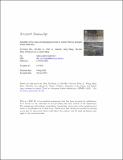Files in this item
Assembly of the Lhasa and Qiangtang terranes in central Tibet by divergent double subduction
Item metadata
| dc.contributor.author | Zhu, Di-Cheng | |
| dc.contributor.author | Li, Shi-Min | |
| dc.contributor.author | Cawood, Peter A. | |
| dc.contributor.author | Wang, Qing | |
| dc.contributor.author | Zhao, Zhi-Dan | |
| dc.contributor.author | Liu, Sheng-Ao | |
| dc.contributor.author | Wang, Li-Quan | |
| dc.date.accessioned | 2016-07-03T23:31:07Z | |
| dc.date.available | 2016-07-03T23:31:07Z | |
| dc.date.issued | 2015 | |
| dc.identifier | 200630115 | |
| dc.identifier | 17d8ae69-21f6-41a9-83b1-882c52b94ba8 | |
| dc.identifier | 84957847770 | |
| dc.identifier | 000371945200002 | |
| dc.identifier.citation | Zhu , D-C , Li , S-M , Cawood , P A , Wang , Q , Zhao , Z-D , Liu , S-A & Wang , L-Q 2015 , ' Assembly of the Lhasa and Qiangtang terranes in central Tibet by divergent double subduction ' , Lithos , vol. In press . https://doi.org/10.1016/j.lithos.2015.06.023 | en |
| dc.identifier.issn | 0024-4937 | |
| dc.identifier.other | RIS: urn:65685667D247B03FAFA3D41594849BD0 | |
| dc.identifier.uri | https://hdl.handle.net/10023/9072 | |
| dc.description | This research was financially co-supported by the Strategic Priority Research Program (B) of the Chinese Academy of Sciences (XDB03010301), the National Key Project for Basic Research of China (2011CB403102 and 2015CB452604), the Chinese National Natural Science Foundation (41225006, 41472061, and 40973026), and the Specialized Research Fund for the Doctoral Program of Higher Education (20120022110001) | en |
| dc.description.abstract | Integration of lithostratigraphic, magmatic, and metamorphic data from the Lhasa-Qiangtang collision zone in central Tibet (including the Bangong suture zone and adjacent regions of the Lhasa and Qiangtang terranes) indicates assembly through divergent double sided subduction. This collision zone is characterized by the absence of Early Cretaceous high-grade metamorphic rocks and the presence of extensive magmatism with enhanced mantle contributions at ca. 120–110 Ma. Two Jurassic−Cretaceous magmatic arcs are identified from the Caima−Duobuza−Rongma−Kangqiong−Amdo magmatic belt in the western Qiangtang Terrane and from the Along Tso−Yanhu−Daguo−Baingoin−Daru Tso magmatic belt in the northern Lhasa Terrane. These two magmatic arcs reflect northward and southward subduction of the Bangong Ocean lithosphere, respectively. Available multidisciplinary data reconcile that the Bangong Ocean may have closed during the Late Jurassic−Early Cretaceous (most likely ca. 140–130 Ma) through arc-arc “soft” collision rather than continent-continent “hard” collision. Subduction zone retreat associated with convergence beneath the Lhasa Terrane may have driven its rifting and separation from the northern margin of Gondwana leading to its accretion within Asia. | |
| dc.format.extent | 1564580 | |
| dc.language.iso | eng | |
| dc.relation.ispartof | Lithos | en |
| dc.subject | Multidisciplinary data | en |
| dc.subject | Divergent double subduction | en |
| dc.subject | Bangong Ocean | en |
| dc.subject | “Soft” Lhasa−Qiangtang collision | en |
| dc.subject | Central Tibet | en |
| dc.subject | GB Physical geography | en |
| dc.subject | NDAS | en |
| dc.subject.lcc | GB | en |
| dc.title | Assembly of the Lhasa and Qiangtang terranes in central Tibet by divergent double subduction | en |
| dc.type | Journal article | en |
| dc.contributor.institution | University of St Andrews. Earth and Environmental Sciences | en |
| dc.contributor.institution | University of St Andrews. School of Geography and Geosciences | en |
| dc.contributor.institution | University of St Andrews. Scottish Oceans Institute | en |
| dc.contributor.institution | University of St Andrews. St Andrews Isotope Geochemistry | en |
| dc.identifier.doi | 10.1016/j.lithos.2015.06.023 | |
| dc.description.status | Peer reviewed | en |
| dc.date.embargoedUntil | 2016-07-04 |
This item appears in the following Collection(s)
Items in the St Andrews Research Repository are protected by copyright, with all rights reserved, unless otherwise indicated.

